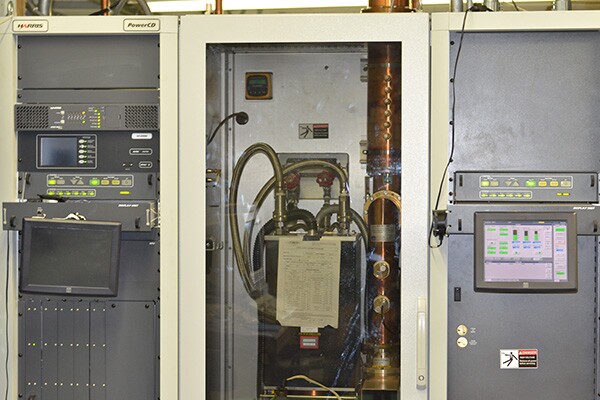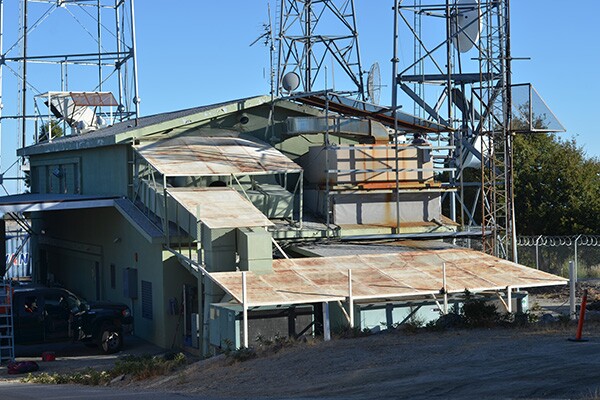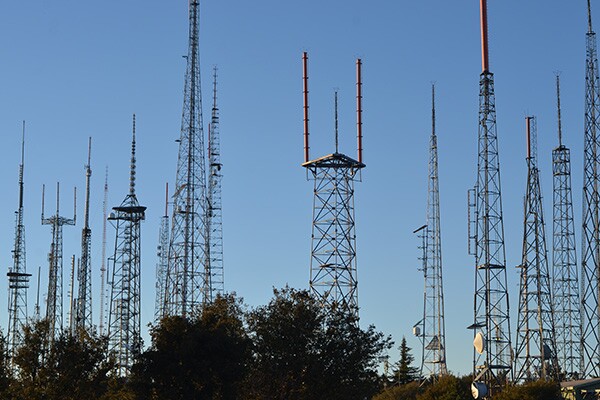Transmitting Live from Mount Wilson: How KCET's Signal Comes to You

Television, by its own design, seems like magic -- you turn on a box (or, nowadays, a panel), and images and sound magically appear out of nowhere. Of course, how those images and sounds find their way to you isn't as magical as the experience of enjoying the content that's being broadcast, but we all know that television signals reach our sets via antenna, cable, or satellite dish.
The exact journey of how those signals travel from the television station to your set is something we usually take for granted, or fail to think about at all, yet it has been a fundamental concern to the people who perform the day-to-day task of keeping KCET on the air for the past 50 years.
Towering northeast of the Los Angeles basin is the stately front range of the San Gabriel Mountains, a natural skyline of up to 6,100 feet looming above the urban expanse we call home. Though the San Gabriels have long been synonymous with the Angeles National Forest, the mountains are home to an entirely different kind of forest -- the forest of television and radio broadcast antennas atop Mount Wilson. In October 2014, President Obama declared a nearly 350,000-acre section of the San Gabriel Mountains as a National Monument, an area that includes KCET's transmitter facility, which is responsible for putting channel 28 on the air.
Visible some 5,500 feet high above the city of Pasadena, KCET's transmitter tower is easy to spot among the crowd; it is the easternmost tower in the entire broadcasting complex, seen to the far right when you look up. Built in the Spring of 1964 around its original General Electric analog TV transmitter, just months prior to KCET first going on the air, the tower and its adjacent, two-story sage green transmitter building is currently the only building that KCET owns.
In late September I was given a personal tour of KCET's Mount Wilson transmitter facility by Jeremy Howard, the station's RF & Transmission Supervisor, who calls the facility his office on most days of the week.

It's clearly a different world up there, with breathtaking views of Southern California; one can see all the way to Catalina Island towards the south, and the Inland Empire towards the east. The downtown Los Angeles skyline looks like a tiny outcropping among civilization below. And as the bustling metropolis roars with the cacophony of traffic and urban noise, only the wind dares to make a sound up on the mountaintop. When rain falls on the rest of the city during winter storms, snow is a common sight on the mountain. The famed Mount Wilson Observatory is just a short hike to the east, and wildlife such as rattlesnakes, California grey squirrels and black bears might even greet you on occasion.
So how does KCET's signal get to your television?
For those who tune into KCET via a major cable television or satellite provider such as Time Warner Cable, Comcast, DISH Networks, or DirecTV, KCET's HD digital signal and that of its three standard-definition sub-channels (KCETLink, V-Me*, and NHK World) are transmitted directly to your provider's central facility via underground fiber optic lines.
But if you receive KCET through on-the-air antenna or through a small local cable provider, KCET's signal travels from our studio in Burbank to the Mount Wilson facility via fiber optic line, with a 7-gigahertz microwave dish link from the top of our studio building to the mountain acting as a backup.
"We want to be as redundant as possible," said Howard.

From there, the signal's journey has just begun. Both the fiber-optic data and microwave signal enter a receiver, where they are channeled to the heart of the facility's operation: The 30,000-watt Harris digital transmitter.
The size of three refrigerators placed side-to-side, the transmitter is what keeps KCET's HD channel and its three sub-channels on the air.
The incoming digital signal stream is fed through a component called an exciter, which turns the data stream into low-power radio frequencies. The signal then enters an intermediate power amplifier, which bumps the power of the signal to 100 watts, which is what is necessary to drive the transmitter tube, a black box standing just over three feet tall, crowned with a series of tubes and pipes. The 30-kilowatt output generates large amounts of heat, so an intricate water and air cooling system, not unlike the cooling system of an automobile, keeps the tube from overheating by maintaining an operating temperature of 150 degrees Fahrenheit.
The transmitter is powered by 480 volts of AC power from Southern California Edison, which is fed into an outdoor transformer that converts that electricity into 34,000 volts of DC power, which runs the tube. Replete with LED lights and touchscreen computer monitors that run status and diagnostic applications, the high-tech transmitter has been in operation since KCET fully transitioned to digital broadcasting in 2009.
"It's a pretty dangerous piece of equipment if you don't know how to play with it properly," said Howard.
The signal then is channeled to the second floor where it enters a preliminary filter, and then to a tank-like container called a mask filter, which restricts the signal to within its 6-megahertz bandwidth and its channel 28 frequency, as mandated by its broadcasting license with the Federal Communications Commission. Then it travels through heavy-duty wires which resemble copper plumbing pipes, outside the building to the adjacent 300-foot transmitter tower, where it terminates at the 73-foot digital television antenna at the top. The antenna leans at a precise angle to most effectively beam out its signal to household TV antennas in the Los Angeles basin below.
For KCET viewers who are out of direct range of the Mt. Wilson antenna's signal, a number of repeater towers, in places like eastern Ventura County and near Palm Springs, receive the signal, re-amplify it, and broadcast it out to households in those regions.
Though KCET owns its own transmitter facility, it exists in an interesting real estate arrangement: KCET leases the actual land from KTTV Fox 11, who has owned the parcel since before KCET went on the air. Additionally, the transmitter facility is shared with television station KLCS 58 and FM radio stations KKLA 99.5 and KSCA 101.9, all of whom pay rent to KCET for use of the facility, generating additional revenue for the station.

But what would happen in case of an emergency?
The transmitter facility includes several fail-safe and back-up systems to keep KCET and its broadcast tenants on the air. In case of power failure, a large diesel-powered backup generator, which sits just outside the building, will run all four stations automatically for up to 36 hours, ample time to have repair crews arrive and fix any issues.
"It's important to have these [systems], it's a long way to the bottom of the hill," Howard said.
The transmitter facility's distance -- some 45 minutes each way of mountain road driving -- also makes it practical for the building to house its own manufacturing machinery to fabricate parts.
The building also includes a backup solid state digital TV transmitter, which was the original digital transmitter used by KCET when the station tested its digital TV broadcasts from 2000 to 2009. And if the antenna goes down, a smaller backup antenna is ready to be of service.
"If we were to have a major loss, like a problem with the transmission line, or the antenna burned up, or we had a lighting strike, all we have to do is flip a switch in master control, and we can run the backup tower...as far as our viewers know, they'd never know the difference," said Howard.
It's an under-appreciated, but extremely fundamental task, done every day for the past 50 years, to keep KCET running on the air. That magic you see when you turn on your television sets requires a lot of electricity, a lot of equipment, and a lot of backup systems in order to happen.
*This article makes reference to Vme. As of Mar. 30, 2017, Vme is no longer distributed by KCET. Click here for more information.
